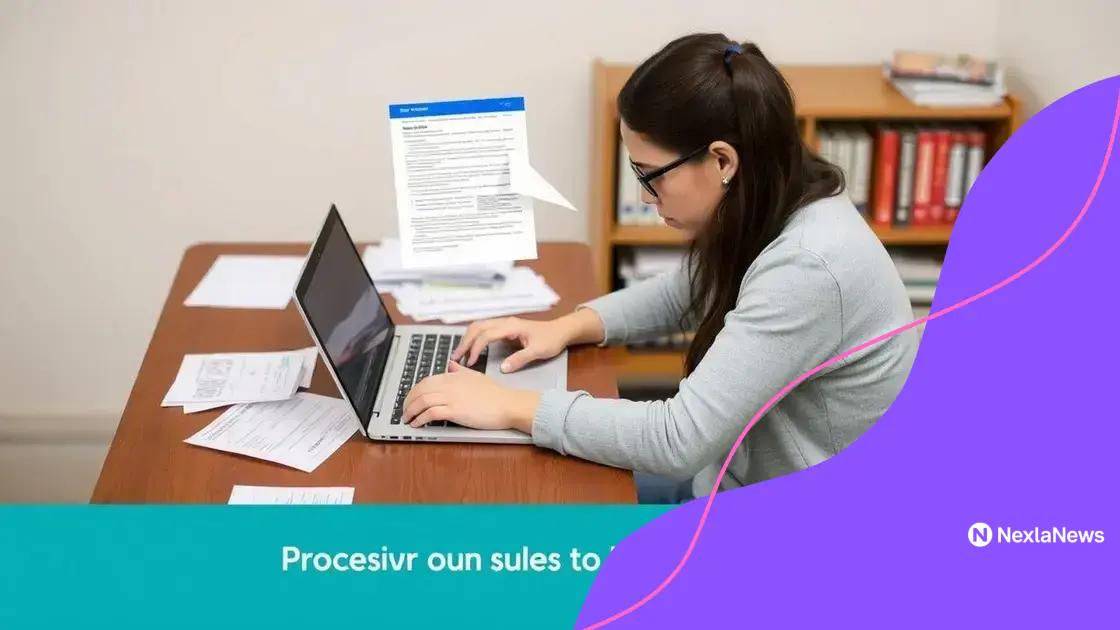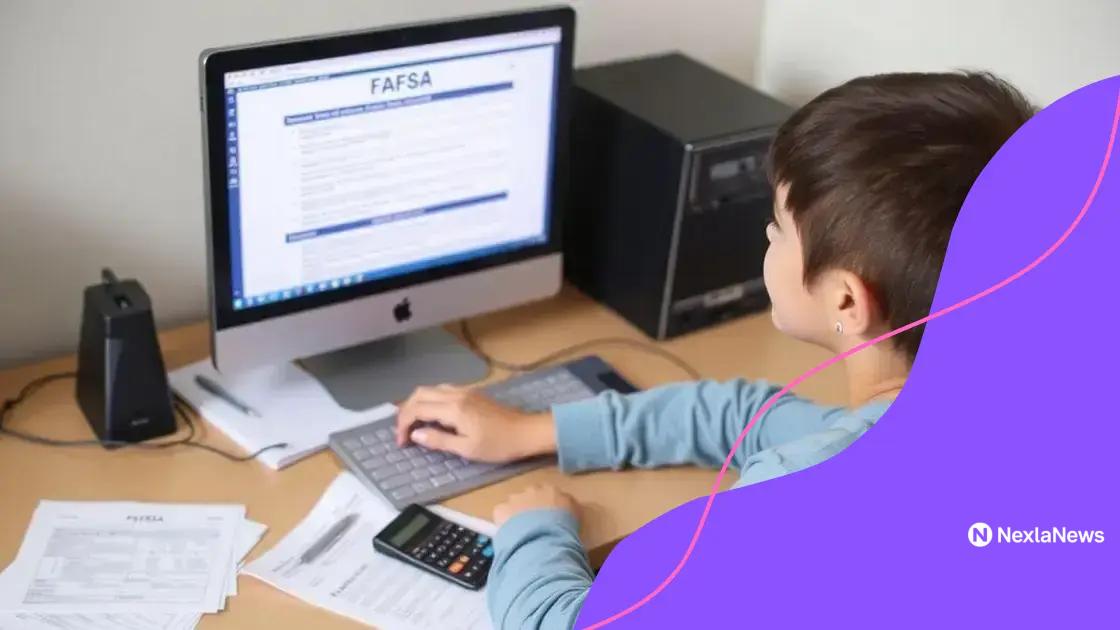FAFSA help: navigate your financial aid options

FAFSA help is essential for securing financial aid for college, requiring accurate information, understanding deadlines, and avoiding common mistakes to maximize your eligibility.
FAFSA help can transform your approach to financing your education. Are you aware of all the resources available to ease the application process? Let’s dive into how you can make the most of this opportunity.
Understanding FAFSA and its importance
Understanding FAFSA is crucial for any student looking to receive financial aid for college. The Free Application for Federal Student Aid is the gateway to federal loans, grants, and work-study programs. Knowing how it works can greatly enhance your chances of securing the funds you need.
What is FAFSA?
The FAFSA is an application used by the U.S. Department of Education to determine a student’s eligibility for financial aid. By filling out this form, you provide information about your income, family size, and other factors that affect your financial situation.
Why is FAFSA important?
Completing the FAFSA is essential because:
- It opens doors to various types of financial aid, including grants and scholarships.
- Many states and colleges require FAFSA for their financial aid programs.
- It can help you take on lower student debt.
Understanding the importance of FAFSA means recognizing its role in making higher education more accessible. Not only does it provide critical financial support, but it also enables students to plan for their future without overwhelming debt.
The application process may seem intimidating, but breaking it down step by step can simplify things. Focus on gathering the necessary documents, such as tax returns and Social Security numbers. This preparation will make completing the FAFSA smoother and more efficient.
Overall, getting familiar with FAFSA is advantageous for students. The knowledge gained from understanding how to properly navigate the form can result in significant financial assistance. Don’t hesitate to seek help if needed, as many resources are available.
Eligibility requirements for FAFSA
Understanding the eligibility requirements for FAFSA is a key step in securing financial aid for your education. To qualify, you need to meet several criteria that outline your financial and academic background.
Basic eligibility criteria
To be eligible for FAFSA, you must:
- Be a U.S. citizen or an eligible non-citizen.
- Have a valid Social Security number.
- Be enrolled or accepted for enrollment in an eligible degree or certificate program.
These basic requirements are essential for applying. As a student, it’s important to ensure you meet them before submitting your application. Failing to meet these criteria can lead to complications or delays in receiving aid.
Academic progress
Another important aspect of FAFSA eligibility is satisfactory academic progress. Schools have standards for maintaining a certain GPA and completing coursework on time.
If you’re a returning student, your previous academic performance may also affect your eligibility. It’s vital to stay informed about your school’s policies to ensure you remain eligible for funding.
In addition to academic requirements, your financial situation plays a significant role. The FAFSA assesses your family’s financial strength, so be prepared to provide information about income, assets, and the number of family members supporting their education.
These factors combined will give a complete picture to determine your eligibility for financial aid. Understanding how they affect your FAFSA application can empower you to make informed decisions as you plan for your education.
How to complete the FAFSA form

Completing the FAFSA form can seem overwhelming, but with the right steps, it becomes manageable. First, make sure you have your necessary documents, like your Social Security number and tax returns, ready before you begin.
Gather required documents
Important documents include:
- Your Social Security number or your alien registration number.
- Federal tax information from your previous tax year.
- Information about your bank accounts and investments.
Having these documents on hand will streamline the process. Once you have everything ready, you can start filling out the FAFSA form.
Filling out the form
Begin with the personal information section. Make sure to enter your name and other details exactly as they appear on your Social Security card. For dependent students, you’ll need to include your parent’s information as well. It’s important to stay honest and accurate throughout.
Next, you will input financial information. If your parents filed taxes, you will use their tax returns unless they are exempt. If you are filing as an independent student, include your own financial information.
After entering all financial details, complete the section regarding your school choices. You can list up to ten schools on your FAFSA form. This is a great way to ensure that all your preferred institutions receive your information.
Once everything is filled out, double-check your entries. Small mistakes can lead to delays in processing your application. Once you’re sure all information is correct, submit your FAFSA form electronically.
After submission, you’ll receive a confirmation email. Keep this email as proof of your application. If you encounter any issues, many resources are available to assist you.
Common mistakes to avoid when filling FAFSA
When submitting the FAFSA application, it is essential to avoid common mistakes that could delay or reduce your financial aid. Awareness of these pitfalls can lead to a smoother application process and better results.
Incorrect personal information
One of the most frequent errors is entering incorrect personal information. Make sure your name, Social Security number, and date of birth match the details on your Social Security card precisely. Even a small typo can cause issues.
Not using the proper tax information
Another mistake is not providing the correct tax information. You should use the most recent tax return when filling out the FAFSA. If you estimate your income, make sure to update it later with accurate figures.
Omitting parental information
If you are a dependent student, failing to include your parent’s financial information is a significant error. Ensure all family member details are accurate, as this information is crucial for determining your eligibility for aid.
- Verify that both parents’ income is included if necessary.
- Provide details about all family members living in your household.
- Double-check that you classify your parental status correctly.
Another common issue is missing deadlines. Always pay attention to FAFSA deadlines for federal and state aid. Submitting your application late can mean missing out on financial assistance that could make a substantial difference in your educational journey.
Furthermore, many students forget to sign the form. Make sure to sign your FAFSA electronically or print it out to sign and send if you are completing a paper version. Your application will not be processed without a signature.
By avoiding these common mistakes, you can improve your chances of receiving the financial aid you need. The FAFSA process doesn’t have to be stressful if you stay organized and attentive.
Maximizing your financial aid with FAFSA tips
Maximizing your financial aid through the FAFSA can have a significant impact on your college funding. With the right strategies, you can make the most of your application and increase your chances of receiving aid.
Understanding deadlines
First, it is crucial to know the deadlines for submitting your FAFSA. Be aware of both federal and state deadlines as well as the deadlines set by your chosen colleges. Submitting your application early can enhance your chances of receiving more financial aid.
Provide accurate information
When filling out the FAFSA, ensure the information is accurate. This applies to both personal and financial details. Any errors or inconsistencies can delay processing or lead to reduced aid. Gather all necessary documents, including tax returns and bank statements, to input correct information.
- Double-check your Social Security number.
- Verify that your income information is correct.
- Ensure all family members are accounted for if applicable.
Completing the form accurately increases your eligibility for aid. It is also wise to use the IRS Data Retrieval Tool if available. This tool allows you to transfer your tax information directly into the FAFSA, reducing the risk of errors.
Selecting your schools wisely
Another tip for maximizing your financial aid is to carefully choose the schools you list on your FAFSA. Research schools that offer strong financial aid packages. Sometimes, colleges provide additional aid based on information in your application. Your choices can have a direct influence on the type and amount of aid you receive.
Moreover, consider applying for scholarships. Look for both local and national scholarships that you may qualify for. Many scholarships do not require separate applications and are awarded automatically based on your FAFSA information.
Lastly, if your financial situation changes, report it as soon as possible. Schools can adjust your financial aid if you experience changes, such as loss of income or unexpected expenses. Keeping your financial aid office informed is vital in ensuring you receive the support you need throughout your college journey.
In summary, effectively navigating the FAFSA process is essential for maximizing your financial aid. By understanding eligibility requirements, avoiding common mistakes, and preparing accurately, you can increase your chances of receiving the support you need for college. Remember to pay attention to deadlines, complete your application truthfully, and reach out for help when needed. Utilizing these tips will help you succeed in securing financial aid and focus on your educational goals.
FAQ – Frequently Asked Questions about FAFSA
What is FAFSA?
FAFSA stands for Free Application for Federal Student Aid. It is a form that determines your eligibility for financial aid for college.
How can I maximize my financial aid with FAFSA?
To maximize your financial aid, meet all deadlines, provide accurate information, choose your schools wisely, and apply for scholarships.
What are the common mistakes to avoid when filling out FAFSA?
Common mistakes include providing incorrect personal information, missing deadlines, omitting parental details, and forgetting to sign the application.
What should I do if my financial situation changes after submitting FAFSA?
If your financial situation changes, report it to your school’s financial aid office as soon as possible. They may adjust your financial aid accordingly.
